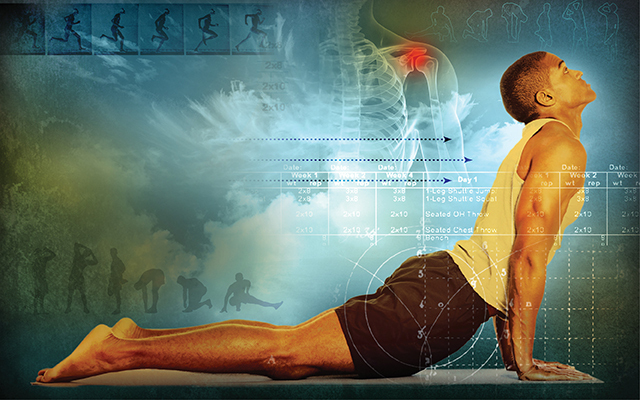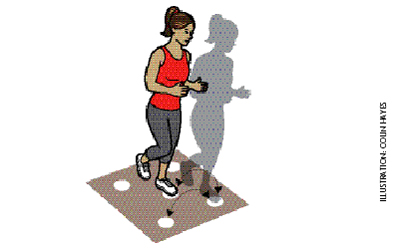Last year, Colleen Callahan was training hard for her first 10K when she began to notice a nagging pain at the base of one of her toes when she ran. The diagnosis? A sprained big toe. The injury surprised her; she didn’t recall experiencing any trauma. But what was really surprising was the cause of the injury: ankle immobility.
“Her Achilles’ tendon was so tight she couldn’t get a proper range of motion in her ankle. She was compensating by pushing off harder with her toe when she ran,” says her sports chiropractor, Darren Hancock, DC, of Chicago Chiropractic and Sports Medicine.
Immobile ankles can wreak havoc all along your kinetic chain. You’ll usually experience some form of knee pain, though it’s not uncommon for the dysfunction to travel as high as the back or shoulders — or as low as a toe.
After a bit of rest, Callahan, 22, began incorporating ankle mobilization exercises into her routine, which allowed her to not only complete her 10K, but also to start training for a marathon. The trick, however, is to improve ankle mobility before it causes trouble — and thereby prevent a lot of needless pain down the road.
The Dorsiflexion Dilemma
Good ankle mobility does not involve being able to roll the ankle laterally. Rather, it means being able to properly dorsiflex your foot (pull it upward) and also plantarflex it (point it downward). “Normal is 20 degrees for dorsiflexion and 50 degrees for plantarflexion. Anything less is considered limited,” says physical therapist Bill Hartman, PT, CSCS, of Indianapolis Fitness and Sports Training.
To approximate what 20 degrees dorsiflexion looks like, place the toes of one foot 2 to 3 inches from a wall, then, keeping your heel on the floor, move your knee forward until it touches the wall. If you can touch the wall without lifting your heel, you’ve achieved 20 degrees.
To eyeball ideal plantarflexion, sit with your legs extended, toes pointing straight up. That’s zero degrees. Now point your toes away from your body; if you can reach an angle just past halfway to the floor, that’s 50 degrees.
Most of us are sorely lacking in the dorsiflexion department. One reason? The calf muscles that control plantarflexion (the gastrocnemius and soleus) tend to be stronger than the muscles that control dorsiflexion (the tibialis anterior), according to Jimmy Smith, MS, CSCS, a strength trainer in Stamford, Conn.
Dorsiflexion detractor No. 2 is immobile plantar fascia in our feet and ankles. Repetitive activity (such as running, jumping or prolonged walking) can cause this band of connective tissue that runs along the bottom of the foot from the heel bone to the base of the toes to shorten and constrict the muscles around the ankle, impeding movement in the ankle itself.
The third factor — tight calves — is probably the most ubiquitous, says Hartman. “It’s a flexibility issue common in 99 percent of the population,” he notes. “Because we sit for long periods of time, walk on nothing but flat surfaces and make poor choices about shoes, we’ve demanded less and less from our bodies,” which essentially causes our body parts to forget what they’re supposed to be doing.
“High heels cause you to lose range of motion because your calf muscles are placed in a shortened position for an extended period of time,” explains Hartman. And high-tops force the knee into a weak, unnatural position as it compensates for the ankle’s lack of mobility.
Monitoring Your Mobility
So how do you know if you have immobile ankles? Knee pain is usually the first sign. Though, as Hartman notes, it can manifest elsewhere. Other indicators include lack of squat depth, premature lifting of the heel while walking or excessive pronation of the foot — all things a physician or physical therapist can help you determine. (See “Screen Test” below.) It’s also possible you have soft-tissue restrictions that need to be worked out by a soft-tissue expert.
Whatever the symptoms, there’s plenty you can do on your own to improve ankle mobility. Consider the suggestions presented below as a step in the right direction.
Screen Test for Ankle Mobility
There’s no substitute for a professional evaluation, but if you want to assess your own ankle mobility, try these self-tests:
Ankle Angle Screen
Bill Hartman, PT, CSCS, suggests using this assessment for ankle mobility:
Stand barefoot, toes pointed forward, facing a wall. Place one foot about 2 inches from the wall, and without lifting your heel, bend your knee until it touches the wall. If you can do this, move back an inch and try again. If you can still touch, you’re doing OK. “Ideal distance is based on limb length, but being able to complete the knee touch with your toes between 2 and 3 inches from the wall demonstrates you’ve got a normal range of dorsiflexion,” says Hartman. (Try with both legs: They should be symmetrical.)
Overhead Squat Press
Have a friend take a few pictures of you doing an overhead squat. Stand with your feet shoulder-width apart. Hold a broomstick or something comparable horizontally over your head. Keep your chest up, back straight, and look ahead.
You should be able to get your thighs perpendicular to the floor. If your arms fall forward past the line of your trunk, then add a heel lift. If the heel lift solves the problem, the issue is primarily in the ankle, says Gray Cook, OCS, CSCS, a physical therapist in Danville, Va.
Ankle Mobility Exercises
Two common causes of immobile ankles are tight calves and immobile plantar fascia along the bottoms of your feet. If either of these problems is restricting your ankles, doing a few minutes of stretching and soft-tissue work every day will improve your ankle mobility, says Bill Hartman, PT, CSCS. If you don’t see improvement in six weeks, seek professional attention.
Massage Your Calves
Stand with left foot forward, knee slightly bent (you may find it easiest to drop down onto your right knee). Using a tennis ball, gently apply pressure just below your gastroc and soleus (large calf muscles) of the left leg. Using a short rocking motion, apply massaging pressure with the tennis ball while you dorsiflex your foot (without lifting your heel, lean knee forward as described in “Ankle Angle Screen” above). Spend a couple of minutes working upward onto your gastroc and soleus. Then repeat on right leg. This exercise will loosen up your calf muscles and thus help increase dorsiflexion, says Hartman.
Stair Stretch
Stand on a step on the balls of your feet and let your heels lower toward the floor. Hold for 30 seconds. Do this with knees straight and then with knees bent, three times per position. You should feel a big stretch in your calves, not a pinch or “stuck” feeling in the front. If the latter occurs, see a physician to rule out a problem in the joint itself.
Play Foot-Ball
Use a golf ball or tennis ball to massage the bottoms of your feet. Work on one square inch at a time. Place firm pressure on the ball with your foot, but do not stand on the ball. Do this for two to three minutes for each foot to reduce tension in the fascia and allow greater dorsiflexion.
Control Mobility
You don’t want to develop mobility without muscle control — otherwise you could be putting yourself at risk for joint instability. These exercises will improve your sensorimotor control and stability. Lower intensity and more frequency is ideal to build endurance in these stabilizing muscles, says Mike Davis, a physical therapist in northern Virginia.
Single Leg Ball Throws
Stand on one foot. Bring your other leg forward and bend it 90 degrees from the knee, thigh parallel to floor. Dorsiflex your foot — pull your toes toward your shin — and have a partner toss you a light medicine ball. Imagine that your torso is broken up into four quadrants (upper right, upper left, lower right, lower left). Have your partner throw to each of those quadrants three times. Switch legs and repeat.
Ankle Alphabet
Trace the entire alphabet in the air using only your foot and ankle. (In other words, don’t move your knee or hip.) Do this a few times a day with each foot to improve controlled mobility.
This article originally appeared as “Rankled by Ankles” in the June 2009 issue of Experience Life.



This Post Has 0 Comments